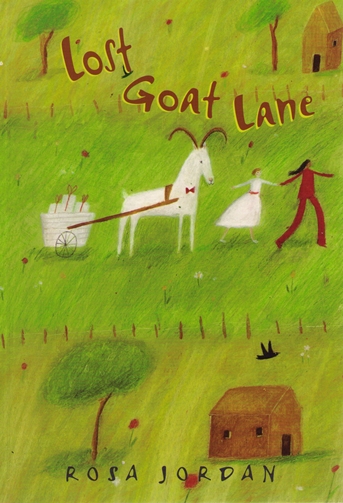
Peachtree
Publishers, Atlanta,2004
Hardback
edition, US$14.95
ISBN
978-1-56145-325-0
Fitzhenry
& Whiteside, Toronto, 2005
Paperback edition,
CDN$12.95
ISBN
978-1-55041-932-3
 |
|
Peachtree
Publishers, Atlanta,2004 Fitzhenry
& Whiteside, Toronto, 2005 |
LOST GOAT LANE
For thirteen-year-old Kate, being one of three kids in a family that’s always broke means feeling ashamed and isolated, especially at school, where her classmates tease her constantly. Things aren’t much better at home. Kate’s mother works long hours at a dairy to make the mortgage payments on their tiny farm. Her older brother Justin talks about running away, and her younger brother Chip has a way of getting into trouble when she’s supposed to be looking after him. And now Kate faces a long hot boring Florida summer with no friends and nothing to do but chores.
But the day Kate’s goat Sugar runs away, things start to get more interesting–and more complicated. That’s when she and her brothers meet the Wilsons, a tight-knit African-American family. Kate is particularly drawn to Ruby, the Wilsons’ glamorous grown daughter who has returned home from New York City. As Kate begins to spend time with Ruby in town she becomes aware of undercurrents of prejudice that run through her community, and the complex roles of race and class in her own relationships.
Recognition
Silver
Birch Honour Book 2006
Red
Maple Children’s Book Award Shortlist 2006
Chocolate
Lily Children’s Book Awards Shortlist, 2006
William
Allen White Children's Book Award Master List for 2006-2007
Kansas
State Reading Circle Recommended Reading List Nominee, 2006
Reviews
KIRKUS, October 1, 2004. Previously presented as the film “The Sweetest Gift,” this tender story features a family abandoned by its father and on the brink of losing its tiny farm. When their goat wanders over to the African-American Wilsons’ house, 13-year old Kate begins to wonder about the roots of prejudice. As she decides if she and her brothers should interact with the elderly Wilsons, she overhears their daughter, Ruby, call them “white trash.” When Kate needs help making do with her old, too-tight clothes and boosting her self-esteem, and Ruby needs assistance with her budding candy business in a small town still known for its racial discrimination, the two form an unlikely bond as business partners and friends. Jordan complements Kate’s genuineness with an interesting locale, filled with threatening alligators and wily farm animals, intergenerational friendship, and a meaningful lesson in tolerance. A treat for middle readers. (Fiction 9-13)
SCHOOL LIBRARY JOURNAL, December 2004. G 5-7. This story is set in rural Florida, and although the characters are close to Palm Beach and Miami, for them it’s as far away as New York. Kate, 13, Justin, 14, and Chip, 7, face a long hot summer of farm chores while their mother works in a nearby dairy. When Kate’s goat runs away, it ends up at the home of a neighboring black couple whose grown daughter doesn’t want her son playing with “white trash,” i.e., Kate’s little brother Chip. However, Mr. and Mrs. Wilson are warm and welcoming, and the three children are made to feel a part of their family. In the meantime, their beloved dog is consumed by an alligator; they survive a hurricane, taking all of the animals into the house; and worry about losing their home when their mother can’t pay the mortgage. This episodic novel focuses on Kate as she learns a lot about herself, her family, and prejudice. The message about learning to make family with those around you and to look at people’s hearts, not their skin or shabby clothes, is obvious, but the fully realized characters and the warmth of the story make up for the small sermons. A tender, satisfying offering.–Amy Patrick, New York Public Library
BULLETIN
OF THE CENTRE FOR CHILDREN’S BOOKS, February 2005. G 4-8.
Often
left on their own while their mother works, Justin, Kate, and Chip
become acquainted with their nearest neighbors, the Wilsons, when
Kate’s nanny goat decides to visit their billy goat. After initial
suspicion, the Wilsons’ daughter, Ruby, enters into an unlikely
friendship with Kate, with Ruby helping Kate learn how to be proud of
her developing body, and Kate helping Ruby start her own business.
The families become further intertwined as the Wilsons’ son,
Booker, helps Justin realize that he has to fight for his dreams
rather than giving up when things look hard. Mom’s discovery of
these friendships makes her unreasonably angry, causing Kate to worry
that her mother is prejudiced (the Wilsons are black), but it turns
out the situation is more complicated: as a divorced woman in a
small Florida town in the 1970s, Mom worries not only about
appearances but also the possibility that the Wilsons will judge her.
Jordan packs a lot of moral complication and wisdom into a
well-crafted and often suspenseful story, which is based on a cable
movie for which she wrote the screenplay. Her characterizations are
multilayered and believable; with Kate as focalizer, the reader has to
suspend his or her own prejudgments on a moody and unreachable older
brother, a cranky mom, and a potential friend with a generally testy
attitude and mercurial mood swings. Booker is a bit too good to be
true, in the usual style of a wounded healer (his baseball career was
cut short when he lost his feet in a land-mine incident in the war),
but the book carries its uplifting message of the power of
friendships lightly enough to keep the story buoyant.–KC